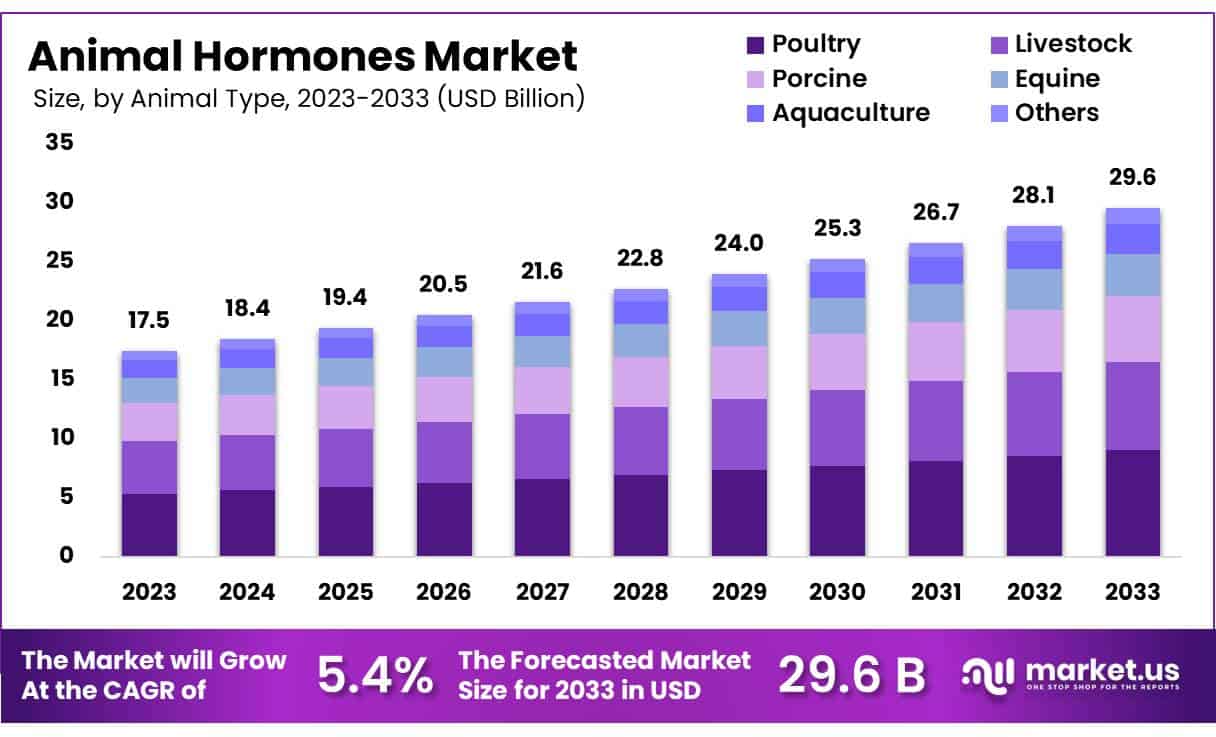Table of Contents
Overview
New York, NY – Oct 08, 2025 – Global Animal Hormones Market size is expected to be worth around US$ 29.6 Billion by 2033 from US$ 18.4 Billion in 2024, growing at a CAGR of 5.4% during the forecast period 2024 to 2033.
The global demand for animal hormones is experiencing steady growth, supported by rising applications across veterinary healthcare, animal husbandry, and pharmaceutical development. Animal hormones are biological messengers secreted by endocrine glands, playing a vital role in regulating metabolism, reproduction, growth, and immunity in livestock and companion animals.
The growth of the animal hormone market can be attributed to the increasing prevalence of animal diseases, rising awareness of animal health, and the need for enhanced productivity in livestock farming. Hormonal therapies are widely used in veterinary medicine to treat reproductive disorders, growth deficiencies, and metabolic imbalances. Additionally, hormone-derived products are being utilized in the development of vaccines, fertility treatments, and performance enhancers, further expanding market opportunities.
Technological advancements in biotechnology and molecular biology have enabled the large-scale synthesis of animal hormones, reducing dependency on natural extraction methods. This innovation has not only enhanced production efficiency but also ensured the availability of safer, standardized formulations for veterinary use.
The Asia-Pacific region is emerging as a significant market due to its expanding livestock sector and growing investments in veterinary healthcare infrastructure. Meanwhile, North America and Europe remain mature markets, supported by strong regulatory frameworks and advanced pharmaceutical research.
With increasing research investments and expanding applications, the animal hormone market is expected to witness sustained growth, offering opportunities for key players in pharmaceuticals, veterinary healthcare, and biotechnology.

Key Takeaways
- Global Animal Hormones Market size is expected to be worth around US$ 29.6 Billion by 2033 from US$ 18.4 Billion in 2024, growing at a CAGR of 5.4% during the forecast period 2024 to 2033.
- By animal type, the market is segmented into poultry, livestock, porcine, equine, aquaculture, and others. Poultry dominated the segment in 2023, accounting for 30.5% of the total market share.
- Based on application, the market is categorized into performance enhancers, growth promoters, and others. Growth promoters emerged as the leading category in 2023, representing 45.2% of the market share.
- In terms of regional performance, North America led the market in 2023 with a share of 39.4%, supported by advanced veterinary practices and strong pharmaceutical demand.
Regional Analysis
North America accounted for the largest share of the animal hormones market in 2023, contributing 39.4% of total revenue. The region’s dominance is driven by the growing need to improve livestock productivity and meet rising consumer demand for animal-derived products. Hormone applications, particularly in cattle and poultry farming, have been widely adopted to enhance growth rates, increase milk yields, and improve overall animal health.
According to the National Agricultural Statistics Service (NASS), the United States maintained a cattle population of approximately 93.6 million in 2021, highlighting the scale of livestock operations. Investments in advanced veterinary medicine, coupled with innovative farming practices, have accelerated the adoption of hormone-based solutions.
Furthermore, regulatory support from bodies such as the U.S. Food and Drug Administration (FDA), which has established stringent guidelines for the safe use of growth promoters, has reinforced market growth. Rising awareness of animal health and productivity standards continues to fuel demand for hormone products in the region.
Frequently Asked Questions on Animal Hormones
- What are animal hormones?
Animal hormones are biochemical messengers secreted by endocrine glands that regulate vital functions such as growth, metabolism, reproduction, and behavior. These hormones maintain internal balance and enable animals to adapt to environmental changes effectively. - What are the main types of animal hormones?
The primary types of animal hormones include steroid hormones, peptide hormones, and amine hormones. Each type influences different physiological processes, such as reproduction, stress response, metabolism, and immune regulation in animals. - Why are animal hormones important in physiology?
Animal hormones are essential for regulating biological systems, including reproduction, energy balance, and stress response. They play a central role in maintaining homeostasis, ensuring survival, and enabling adaptation to environmental or seasonal variations. - How do animal hormones affect reproduction?
Reproductive hormones such as estrogen, progesterone, and testosterone regulate reproductive cycles, gamete production, and mating behaviors. Their balanced function ensures fertility, healthy offspring development, and reproductive efficiency in both wild and domesticated animals. - Can animal hormones be artificially synthesized?
Yes, many animal hormones can be artificially synthesized in laboratories. Synthetic hormones are used in veterinary medicine for growth regulation, fertility management, and disease treatment, ensuring controlled and consistent benefits in livestock management. - What factors are driving the growth of this market?
The growth of the animal hormones market is driven by increasing demand for animal-derived food, rising adoption of advanced veterinary practices, and expanding livestock production. The need for higher yield efficiency strongly influences market expansion. - Which regions hold significant market share?
North America and Europe currently dominate the animal hormones market due to advanced veterinary infrastructure and large-scale livestock farming. However, Asia-Pacific is expected to witness rapid growth, supported by rising meat consumption and agricultural modernization.
Conclusion
The global animal hormones market is projected to experience sustained growth, driven by increasing demand for livestock productivity, advanced veterinary practices, and expanding applications in pharmaceutical and biotechnology sectors. The market size is expected to reach USD 29.6 billion by 2033, growing at a CAGR of 5.4% from 2024.
Poultry and growth promoters dominate key segments, while North America leads with strong regulatory support and advanced infrastructure. Asia-Pacific is emerging as a high-growth region due to its expanding livestock industry. Overall, technological innovation, rising disease prevalence, and growing awareness of animal health are set to reinforce market expansion.
Discuss your needs with our analyst
Please share your requirements with more details so our analyst can check if they can solve your problem(s)



